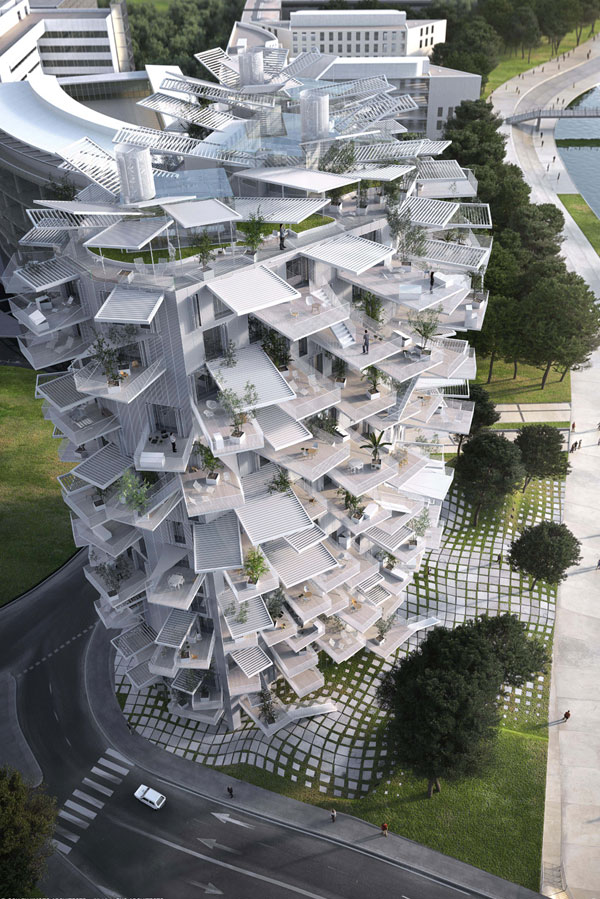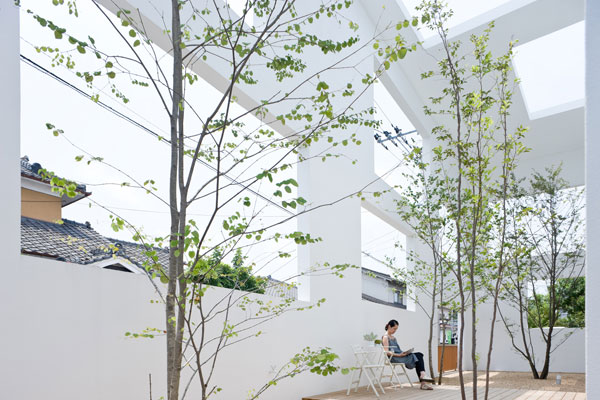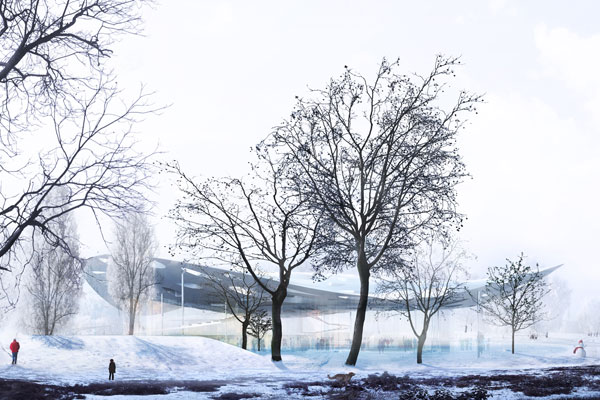TOTO GALLERY·MA hosts a new exhibition, Sou Fujimoto: Futures of the Future, which explores the possibilities of future architecture by taking a close look at the young architect’s practice. Joanna Kawecki has the story.

April 30th, 2015
Top Image: Serpentine Gallery Pavilion (London, England, 2013). Photo: Iwan Baan
In the unassuming gallery space of the TOTO building’s third floor premise in Tokyo’s suburb of Nogizaka, TOTO GALLERY・MA, hosts a new exhibition developed and coordinated by the young and renowned Japanese architect, Sou Fujimoto. Sou Fujimoto: Futures of The Future looks at the possibilities of architecture of the future through Fujimoto’s own practice and conceptual ideas.
Born in Hokkaido, Fujimoto graduated from the University of Tokyo in 1994 and established Sou Fujimoto Architects in 2000. It was in the same year that his proposal for the Aomori Prefectural Art Museum received second place, where he gained recognition as a young and upcoming architect in Japan. Amongst Japan’s next generation of architects, his alternative approach begins with a focus and awareness of people and spaces, and their relationships with the city. Driven by a true curiosity of questioning the space we occupy, Fujimoto focusses on new perceptions of space and materials to create unexpected new architecture.

Sou Fujimoto. Photo: David Vintiner
Futures of The Future showcases over 111 handmade rough-cut model sculptures of past and current projects, some realised and unrealised, presented in the first gallery and outdoor courtyard space. A mirrored wall erected by Fujimoto himself reflects both the indoor and outdoor models, expanding both spaces and dialogue between each project. He explains that each project realised and unrealised provides an inspiration for the next, making each interrelated and connected to the other.
Original models of his global and local works are unveiled, including the brass wire mini model of the Serpentine Gallery Pavilion 2013 (London, England, 2013), or the waxed paper model of the recently complete Naoshima Pavilion 2016 (Kagawa, Japan, 2015). Additional projects include House NA (Tokyo, Japan, 2011), Musashino Art University Museum & Library (Tokyo, Japan, 2010), and the eagerly anticipated L’Arbre Blanc in Montpellier, France, which is currently under construction.

L’Arbre Blanc (Montpellier, France, under construction). Photo: SFA+NLA+OXO+RSI
The exhibition is segmented into categorised and numbered explorations such as ‘Between Nature and Artifice’, or ‘Layered Terrain/ Architecture with Undulation’ encouraging a developing journey throughout Fujimoto’s conceptual thought-process. His invaluable ideas and comments are scattered amongst the models, deliberating if “a house and city are in fact the same thing viewed from different perspectives, one form used in different ways. Thus, we could design a city like a house, or a house like a city, and certainly through which create a richer living environment” or questioning a house made simply of bookshelves, or if it is “a house like bookshelves?”
An additional insight into Fujimoto’s conceptual thinking is provided throughout the commentary alongside each model, such as his reflections on the similarities of a forest and a library “people drift through both unintentionally, discovering things beyond comprehension”, or on architecture as gradient in between inside and outside (rather than clear-cut, he philosophies the gradual change of a space from its innermost, private area to an open space).

House N (Oita, Japan, 2008). Photo: Iwan Baan
Architecture isn’t confined to a defined space, a pivotal theory to Fujimoto’s practice that he thoroughly explores through his investigations and projects. In the second gallery, Fujimoto presents ‘Found Architecture’, by placing scale human figures next to ordinary objects such a plant, sponge or even common electrical wiring. He explains, “By placing these objects found in everyday life or in contexts that might first seem coincidental, if not fortuitous, we would soon start to read these objects as architectural spaces. What lies between them is a prelude of new architecture.”

Proposal for Liget Budapest House of Hungarian Music International Design Competition (Budapest, Hungary, 2015). Photo: Sou Fujimoto Architects
By presenting works both realised and unrealised, “Futures of The Future” introduces the architect’s vast ideas and production processes at a pivotal time in the perception and occupancy of space, suggesting an encouraging potential of architecture in the future.
“Architecture could come into being from anywhere. I believe fostering that architecture-to-be into real architecture itself is also architecture. Onward architecture continues,” says Fujimoto.
Sou Fujimoto: Futures Of The Future runs at TOTO GALLERY・MA, Tokyo, from April 17 – June 13, 2015.
Sou Fujimoto Architects
sou-fujimoto.net
TOTO GALLERY·MA
www.toto.co.jp/gallerma/
INDESIGN is on instagram
Follow @indesignlive
A searchable and comprehensive guide for specifying leading products and their suppliers
Keep up to date with the latest and greatest from our industry BFF's!

A longstanding partnership turns a historic city into a hub for emerging talent

Welcomed to the Australian design scene in 2024, Kokuyo is set to redefine collaboration, bringing its unique blend of colour and function to individuals and corporations, designed to be used Any Way!

For Aidan Mawhinney, the secret ingredient to Living Edge’s success “comes down to people, product and place.” As the brand celebrates a significant 25-year milestone, it’s that commitment to authentic, sustainable design – and the people behind it all – that continues to anchor its legacy.

London-based design duo Raw Edges have joined forces with Established & Sons and Tongue & Groove to introduce Wall to Wall – a hand-stained, “living collection” that transforms parquet flooring into a canvas of colour, pattern, and possibility.

“The architecture of the 21st century lays more emphasis on entertainment.” Architect Hiroshi Naito discusses his thoughts on design that emphasizes experience over simple aesthetics.
The internet never sleeps! Here's the stuff you might have missed

‘Civic Vision | Foster + Partners’ is the first comprehensive exhibition of the practice’s work to be held in Australia, providing an in-depth look at its global portfolio of work since it was founded in 1967 by Norman Foster.

A retrospective at Canberra Museum + Gallery honours Enrico Taglietti, shaping the exhibition through his own design principles.